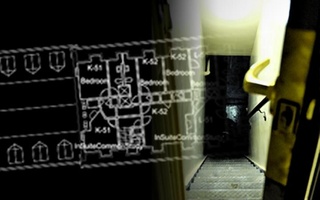Part of the success of “Six Characters” is derived from its comically self-conscious treatment of these esoteric concepts. As the audience takes their seats at a performance of “6 Characters,” a cast is on stage rehearsing another play: “Rules of the Game,” also by Pirandello. “They’re talking about what a terrible play it is and how Pirandello writes this stuff that’s over the audience’s head,” says Jesse T. Nee-Vogelman ’13, Director of the HRDC production. In the midst of the rehearsal, the titular characters enter. Abandoned by their playwright and creator, they demand that their life story be finished and staged. “These characters have a story within them, they’re defined by a story, but they exist in a suspended state until they can perform their story in the theater,” Puchner says. Their interactions with the actors whoplay them are the platform for Pirandello’s meditations on theater itself. His meditations are marked by comical exaggeration of the illusions that complicate that relationship.
“The six characters inhabit several planes of existence,” writes Brandon J. Ortiz ’12, the dramaturge and translator for the production, in an email. “At their lowest level of consciousness, they are the fictional family of their potential play that was never completed by the author. They are also characters that would have been billed in that would-be drama, had it made it to the stage—characters who are now appearing in ‘real life’ during a company’s rehearsal.” And these are just the layers of which the characters are aware.
The great tragedy of the characters, according to Pirandello, is that they cannot break through the final layer of illusion to realize that they serve as amusement for another real audience. At one point, the Lead Actress uses the word ‘illusion’ in passing and elicits signs of discomfort from the six characters. The Father clutches his chest and groans with pain. “It’s just cruel, really cruel to say that word to us,” he says. “Your illusion is the only reality we have.” “They’re not so much acting out the scenes happening to them as living them,” Nee-Vogelman says.
In another seminal moment, the ‘Director’ stops the characters partway through performing a scene and has the actors take their places. The Father quickly objects to his replacement. “He doesn’t look like me, he’s not wearing the right things. This isn’t truth!” The director replies, “Truth? What truth? This is theater, the truth is what we say it is!”
“It’s a really powerful moment of self-questioning,” Ortiz says. “Here are these characters being told by actors that they’re not playing themselves right. It’s a collapse of traditional theater, saying that what we considered to be theater is actually not close to real—and if you put something real on stage, no one would be able to handle it.” Pirandello’s play thus becomes a meditation on the inadequacies of theatrical representation.
THE SUSPENSION OF BELIEF
“Six Characters” addresses these questions by adding extra layers of illusion to the dramatic experience. To the same end, the Neo-Futurists push in the other direction: they attempt to deconstruct the fourth wall completely. “Neo-Futurism is a new approach to theater which espouses the idea that we are ourselves on stage, where we are, at all times,” says Greg Allen, the movement’s founder.
Allen launched the Neo-Futurists as an experimental ensemble in Chicago in 1988. Their first and most famous show, still running after 21 years, is titled “Too Much Light Makes the Baby Go Blind.” It consists of 30 plays performed in 60 minutes. At the beginning of each show, the audience is given menus with a numbered list of the 30 plays to be performed that evening and asked to shout out the name of the show they wish to see next. “It’s kind of this rollercoaster of different ideas and impulses and all sorts of things being thrust at you in a random order, both for the performers and for the audience,” Allen says. An adaptation of the show will run at MIT’s Kresge Little Theater on November 19 and 20. “The Neo-Futurists have written so many plays (they’ve pretty much been continuously writing this show since the 1980s) that we can do it again without having to repeat anything,” writes producer Lindsay Stone in an email. “Additionally, in the fall we like to do shows that involve a large cast so that we can attract lots of actors and designers who hopefully will stick around for our shows for the rest of the year and years to come,” she adds.
To preserve an element of randomness, the Neo-Futurists vary their selection of short shows greatly from week to week based on audience dice rolls. As a result, the Neo-Futurists have produced over 7,500 plays since their founding. “They run from deconstructions of King Lear, to dance pieces, to simply answering questions the audience asks us honestly, to personal monologues, to puppet adaptations of Othello where Othello is an Oreo cookie,” Allen says.
Neo-Futurist shows intend to eradicate the divide between performer and audience. In one show Allen wrote, entitled “Acme,” he comes on stage with an axe. “I find the biggest, toughest guy in the audience, ...hand them the axe and put my head on the chopping block and badger them to chop off my head,” Allen says. The play requires a great deal of faith in the chosen stranger. “It tests our preconceived notions about who he is and what he would do,” Allen says. “We trust [him] to make the right choice.” And if he doesn’t? “Well, it would be big press,” he says.
OPENNESS AND TRUST
This trust represents the central mission of Neo-Futurism. “We try to influence individuals in the audience to take control of their lives, to live thoughtfully and not be passive viewers to what they see everyday. That’s kind of the bottom line, to get people to interact, to engage, and to act with compassion and responsibility,” he says. Allen believes the Neo-Futurist format accomplishes this humanist goal precisely by making the audience an active participant in the theater. The Neo-Futurists claim the originality of their approach creates a format that in itself is intellectual property.
Recently, Boston’s Independent Drama Society (IDS) was planning their own “Neo-Futurist Project” to show at the Democracy Center on Mount Auburn Street and at Boston Latin School. The production would have included 30 plays of varying subject matter, including one based on the classic video game “Duck Hunt,” and one commenting on the practices of the fast-food industry. Joe Gels, the creator of the “Neo-Futurist Project,” had many of the same goals as Allen. “There’s something very rewarding...about the fact that we can get the same kind of reaction from the audience with our own honest feelings about things that we could by pretending to be someone else,” he says.
However, a dispute with the Chicago Neo-Futurists, who permit others to use their model only in limited educational settings, forced the IDS to cancel their production. According to Allen, “one guy made a huge mistake. He didn’t get the rights to do what he was doing.” Allen claims the Neo-Futurists prescribe imitations so strictly is because they don’t want others to misuse their invention and distort its humanist philosophy. “It’s too scary to release the rights to the format. I’ve always used the Nazis as an example—‘30 fascist plays in 60 minutes.’”
Naturally, the IDS was disappointed by the cancellation. “It was difficult to lose all the hard work that the cast invested in the show,” writes Christine Toohey, Director of Marketing for the IDS. She declined to comment on whether or not the Neo-Futurist format should be protected in the realm of intellectual property.
Read more in Arts
Wanderlust: Why We LeaveRecommended Articles
-
 Preserving Some of Harvard’s Best Kept Secrets
Preserving Some of Harvard’s Best Kept Secrets -
 Hasty Pudding Shields John Harvard from Dangerous Tourists
Hasty Pudding Shields John Harvard from Dangerous Tourists -
 Hasty Pudding Shields John Harvard from Dangerous Tourists
Hasty Pudding Shields John Harvard from Dangerous Tourists -
English Department Adds ProfessorsThe English department will welcome two new professors from Columbia University and grant tenure to one of its current associate professors.
-
 'The Picture of Dorian Gray' Gets a Little Wilder
'The Picture of Dorian Gray' Gets a Little Wilder -
Faculty Enthusiastic About Harvard's Move to Online EducationFaculty response to the announcement has been largely positive, with professors across a wide range of disciplines citing not only increased public access but also on-campus advantages and applications of edX.













